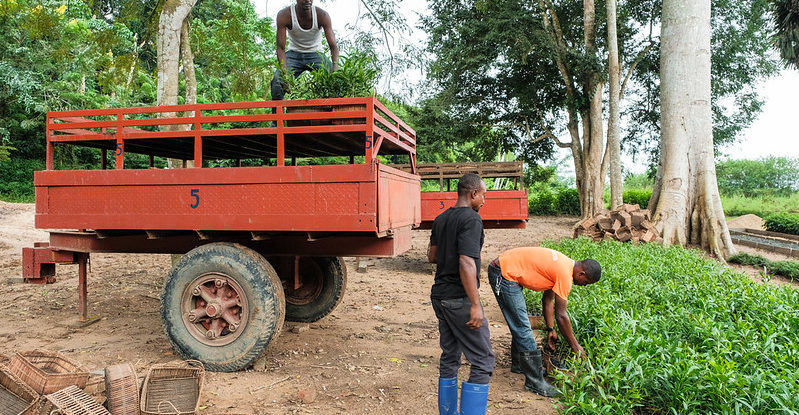
Africa has the potential to restore 700 million hectares of degraded and deforested land, but experts caution that to transform lands and livelihoods over the long term, tree planting initiatives must be bolstered by strong strategies grounded in science.
During the digital forum Can tree planting save our planet? hosted by the Center for International Forestry Research (CIFOR), World Agroforestry (ICRAF) and the Global Landscapes Forum (GLF) on Tuesday, researchers, forestry experts, community leaders, investors and policymakers discussed the keys to successful reforestation and forest landscape restoration.
Here are some top tips on how to get tree planting right:
- Don’t think tree planting, think tree growing
The real challenge is not planting seedlings, but nurturing them so they grow to realize their potential contribution environmental, social and economic benefits over the long-term. “It is essential to choose the right tree for the right place and the right purpose – this is our mantra,” said Ramni Jamnadass, the co-leader of ICRAF’s Tree Productivity and Diversity program. The purpose can be linked to products –fruit, fodder, timber — or services such as shade, erosion control and carbon sequestration. Taking local knowledge, evidence-based approaches and community engagement into consideration are keys to successful forest landscape restoration, according to the experts.
- Watch out for the most common mistakes
“Planting monocultures, introducing invasive species, and ignoring water use and soil water balance are three of the most common pitfalls in tree planting,” cautioned Harrie Lovenstein, head of research and development at the Land Life Company, a reforestation firm headquartered in Amsterdam. Other mistakes include failing to prepare the soil or tailor the approach to the biophysical and cultural realities in a specific location. One more piece of advice from forum participants: Be climate smart, experimenting and selecting variants of Indigenous species that are more tolerant to drought.
- Put local communities at the center of your strategy
Engaging communities and ensuring they benefit from restored forest landscapes is crucial to ensuring long-term success. “Restoration ultimately takes place at the local level, and must take into account the social and economic dynamics in each community,” said Susan Chomba, ICRAF Project Manager. Considerations should include gender, power and age-group dynamics, she added.
- Make the most of mobile applications
New tools that are adapted to local contexts can reduce costs, improve survival rates and support community engagement by helping farmers and restoration practitioners make better decisions. The CIFOR-ICRAF vegetationmap4africa app, for example, allows users to determine which trees and shrubs are native to a location. This information, combined with local knowledge about species that would be most suitable for a particular area and purpose, makes it easier to select the right tree.
Another addition to the toolkit is the Regreening Africa app, presented by CIFOR-ICRAF experts Tor-Gunnar Vagen, Roeland Kindt and Muhammad Ahmad. The application is based on assisted crowdsourcing for monitoring of land restoration at scale. “This tool makes it possible to record, track and improve the performance of restoration efforts,” said Vagen, citing examples from such countries as Rwanda, Senegal, Kenya, Mali, Ghana, Ethiopia and Niger.
- Keep an eye on emerging technologies and ventures
Spatial data, artificial intelligence and drones could transform the future of tree planting. “Manual tree planters will continue being part of the solution, but technology is a way to help us reach the scale we need, faster,” said Lauren Fletcher, founder of BetaEarth.global. “Drones can plant 400,000 seeds per day, versus a few hundred through a manual approach; also, they can access places where we can’t get people.”
Land Life Company is tracking thousands of planted trees through GPS locations, drones and satellites. “This data will allow us to create tree planting maps that can be used by our tree planting machines, and it also feeds into a portal that allows our customers to check in on the trees,” Lovenstein said.
Technology has a role to play, but there will always be a need for the human component, Fletcher said, adding: “I love technology, but you must see it as a tool to be used at the right place and time and for the right purpose.”
- Let nature do the work
In some cases, instead of tree planting, natural forest regeneration can be a solution: “It is a low-cost strategy with no need for nurseries or a large working force, but it is important to assess when and where it is possible,” said Joice Ferreira, a researcher at Brazil’s Embrapa Amazônia Oriental (Brazilian Agricultural Research Corp., Eastern Amazon).
Discussing her research in the Brazilian Amazon, Ferreira explained that secondary forests have recovered 80 percent of their primary forest levels of carbon and biodiversity in only four years. This has been possible due to optimal temperatures and rainfall, and the fact that land use change in the area is relatively recent, occurring within the past 30 years, and not always intensive – agricultural activities often consist in extensive pastures.
“Among policy-makers, there is much more enthusiasm about tree planting, even when it is not necessary at all,” she said. “Globally, there are many opportunities for natural regeneration; we should take advantage of them.”
We want you to share Forests News content, which is licensed under Creative Commons Attribution-NonCommercial-ShareAlike 4.0 International (CC BY-NC-SA 4.0). This means you are free to redistribute our material for non-commercial purposes. All we ask is that you give Forests News appropriate credit and link to the original Forests News content, indicate if changes were made, and distribute your contributions under the same Creative Commons license. You must notify Forests News if you repost, reprint or reuse our materials by contacting forestsnews@cifor-icraf.org.
Further reading
Tree planting is critical for sustainable future but can’t fix climate change on its own
Attention investors: African entrepreneurs are restoring land and making profit
Dispelling the top seven tree-planting misconceptions
Young entrepreneurs see business opportunity in rural Africa’s degraded lands